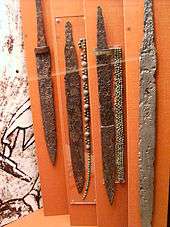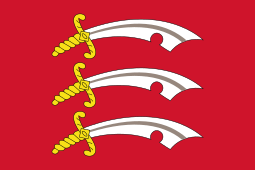Seax
Seax (Old English pronunciation: [ˈsæɑks]; also sax, sæx, sex; invariant in plural, latinized sachsum) is an Old English word for "knife".[1] In modern archaeology, the term seax is used specifically for a type of small sword, knife or dagger typical of the Germanic peoples of the Migration period and the Early Middle Ages, especially the Saxons, whose name derives from the weapon.[2] These vary considerably in size, but are mostly all-purpose tools and weapons, often carried by women as well as men.

In heraldry, the seax is a charge consisting of a curved sword with a notched blade, appearing, for example, in the coats of arms of Essex and the former Middlesex.[3]
Old English seax, sax and Old Frisian sax are identical with Old Saxon and Old High German saks, all from a Common Germanic *sahsą from a root *sah, *sag- "to cut" (also in saw, from a PIE root *sek-). In Scandinavia, the words sax, saks or sakset all refer to scissors, which are used for cutting various materials. The term scramaseax or scramsax (lit. "wounding-knife") is sometimes used for disambiguation, even though it is not attested in Old English, but taken from an occurrence of scramasaxi in Gregory of Tours' History of the Franks.[4]
The name of the roofer's tool, the zax, is a development from this word.[5]
Description

Amongst the shape and construction of seaxes there is a great deal of variation. The most frequent characteristics are:
- A tang in the centerline of the blade, inserted into an organic hilt (wood, horn)
- A large single-edged blade
- The blade is worn horizontally inside a scabbard attached to the belt, with the edge of the blade upwards
In the continental Germanic area, the following types are defined for seaxes between roughly 450 and 800 AD, in chronological order:[6]
- Narrow long seax
- Short seax
- Narrow seax – Often have braided bands or snakes engraved in the blade, and frequently include metal bolsters and pommels. Both the edge and the back are curved towards the tip, which is generally located above the centerline of the blade.
- Light broad seax – Similar to narrow seax, but frequently lack metal hilt parts, and have simpler decorations on the blade, such as parallel lines. Both the edge and the back curve towards the tip, which is generally located at the centerline of the blade.
- Heavy broad seax – Have simple decorations on the blade if any, and long single-part organic hilts (>20 cm). Both the edge and the back curve towards the tip, which is generally located at the centerline of the blade.
- Atypical broad seax – Same as heavy broad seax.
- Long seax – Blades are 50 cm/20 in or longer, often with multiple fullers and grooves, pattern welded blades, and long hilts similar to broad seaxes. The edge is generally straight, or curved slightly towards the tip. The back either curves gently, or with a sharp angle towards the tip, which is located below the centerline of the blade.
The general trend, as one moves from the short to the broad seax, is that the blade becomes heavier, longer, broader and thicker. Long seaxes, which arrived at the end of the 7th century, were the longest of the seax. These were narrower and lighter than their predecessors. Initially, these weapons were found in combination with double-edged swords and were probably intended as side arm. From the 7th century onwards, seaxes became the main edged weapon (next to a francisca), sometimes in combination with small side-knives.[6]
The rest of Europe (except for parts of Scandinavia) followed a similar development, although some types may not be very common depending on location. In England long seaxes appear later than on the continent and finds of long seaxes (as opposed to knives) remain very rare in comparison to finds of swords throughout the period.[7][8]

Another typical form of the seax is the so-called broken-back style seax. These seaxes have a sharp angled transition between the back section of the blade and the point, the latter generally forming 1/3 to 3/5 of the blade length, exactly like a large version of a modern clip-point blade. These seaxes exist both in long seax variety (edge and back parallel) and in smaller blades of various lengths (blade expanding first, then narrowing towards the tip after the kink). They occurred mostly in the United Kingdom and Ireland, with some examples in Germany around 8th-11th century. Some examples have pattern welded blades, while others have inlays of silver, copper, brass, etc.

See also
- Kragehul lance
 Three heraldic seaxes on the flag of Essex
Three heraldic seaxes on the flag of Essex - Migration Period sword
- Migration Period spear
- Seax of Beagnoth

References
- Bosworth, Joseph, D.D., F.R.S. An Anglo-Saxon Dictionary Archived 2008-05-09 at the Wayback Machine. Retrieved 16 July 2008.
- "Saxon". Oxford English Dictionary (3rd ed.). Oxford University Press. September 2005. (Subscription or UK public library membership required.)
- "Heraldry (S)". Probertencyclopaedia.com. 2006-11-01. Retrieved 2010-09-16.
- Medieval Sourcebook History of the Franks
- George Ripley and Charles Anderson Dana (1862). "SLATE". The New American Cyclopaedia: a popular dictionary of general knowledge. New York: D. Appleton and Company. p. 695.
- Schmit, George Die Alamannen im Zollernalbkreis Archived 2012-02-13 at the Wayback Machine. Retrieved 16 July 2008.
- Underwood, Richard (1999) Anglo-Saxon Weapons and Warfare Stroud, England: Tempus, ISBN 0-7524-1910-2 p70.
- Gale, David (1989) The Seax in Weapons and Warfare in Anglo-Saxon England Oxford, England: Oxbow ISBN 0-947816-21-6
External links
| Wikimedia Commons has media related to Seax. |
- The Anglo Saxon Broken Back Seax (myArmoury.com article)
- Regia Seax
- British Museum:Seax of Beagnoth
- Andrew Thompson, The Seax (Two Handed?), 3 October 2011, The Thegns of Mercia